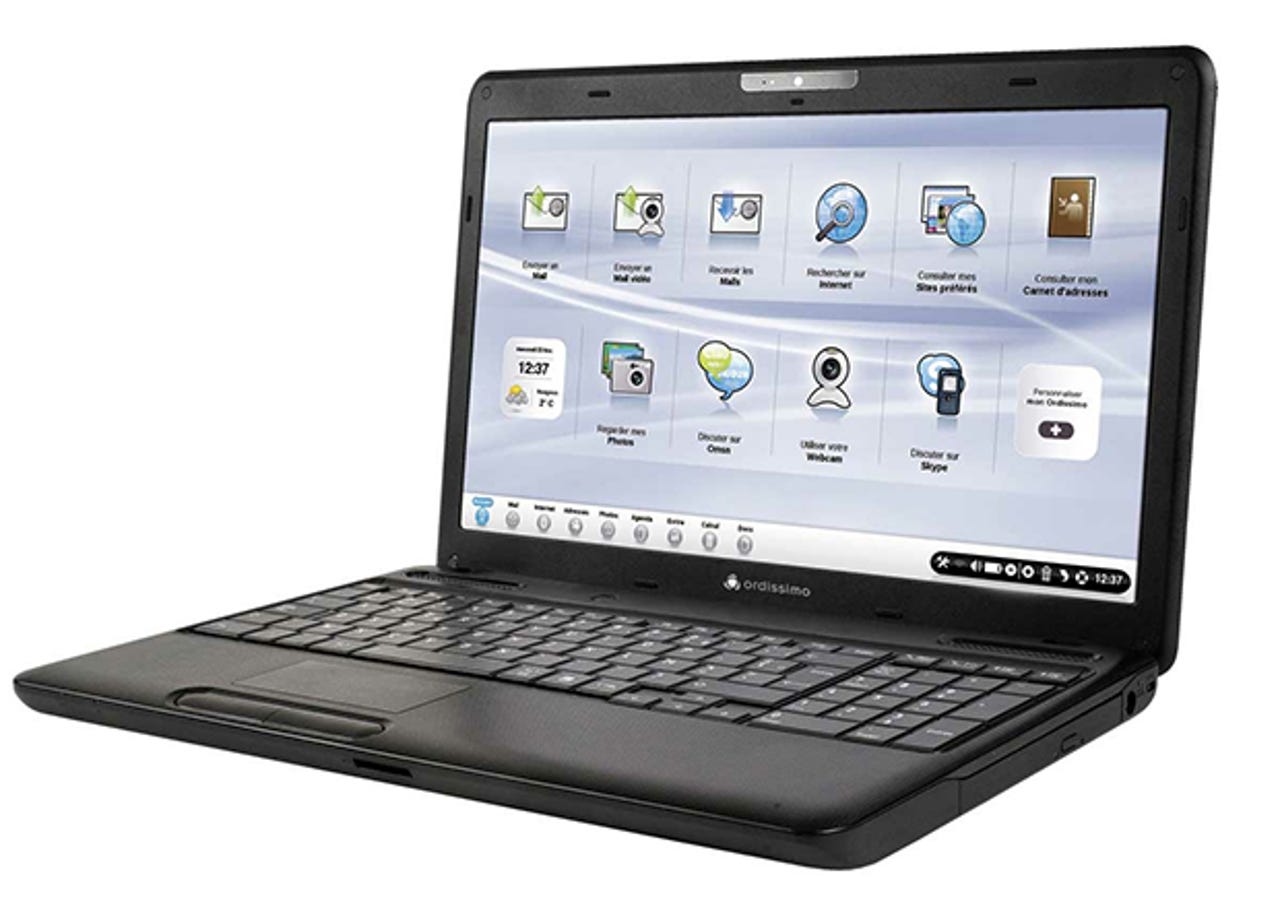Ordissimo Laptop 15"

There has been a fair amount of recent 'buzz' around a pair of Ordissimo notebooks from a French company called Substantiel SAS. In fact, Linux-based Ordissimo computers — whose key selling point is ease of use — have been available in Europe since 2005, but the current generation of 15in. and 17in. notebooks are the first to become available in the UK.
We looked at the Laptop 15" — which is, in fact, a 15.6in. Toshiba Satellite C660D-14C running a customised Debian-based Linux distribution and including a simplified keyboard overlay that provides one-button access to applications and a range of common functions. The idea is to appeal to people — particularly the over-50s — who have so far resisted computers and the internet. The Laptop 15" costs £599 (inc. VAT), while its 17in. sibling costs £899 (inc. VAT).

As noted above, the hardware is pretty straightforward: underneath the Ordissimo branding, it's a 15.6in. (1,366 by 768) Toshiba Satellite C660D-14C with an AMD E-300 APU (including Radeon HD 6310 graphics), 3GB of RAM, a 320GB hard drive spinning at 5,400rpm, 802.11b/g/n Wi-Fi and a built-in optical drive. Connections run to VGA, Ethernet, two USB 2.0, microphone and headphone. The system measures 38cm wide by 25cm deep by 2.8cm thick and weighs 2.4kg. The system's 48Whr lithium-ion battery is rated (by Toshiba, under Windows 7) for 5 hours 15 minutes' life.
The only notable aspect of the hardware is Ordissimo's keyboard overlay, a rubberised sheet at that sits atop the standard Toshiba keyboard. This provides buttons to access the home screen, the key bundled applications (Mail, Internet, Addresses, Photos, Agenda, Write, Spreadsheet), the Docs folder and the webcam. There are also buttons for common functions like Copy and Paste, Zoom in/out and Print that normally require key combinations or several mouse clicks.
The Debian-based Linux OS with its user-friendly Ordissimo GUI and modified apps is the main innovation, of course. The system boots into a home screen with a three-by-six grid of large icons for Send an Email, Send a Video Email, Get my Emails, Search on the Web, Check my Favourite Sites, Check my Address Book, See my Photos, Webcam and Skype, plus any others you've managed to install from the app store (of which more below). The bottom-left position has an icon showing the date, time and local weather, while the bottom right icon, 'Customise my Ordissimo', takes you to a screen where you can add or delete applications.
When we selected Inkscape, the vector graphics editor, from the app store, the icon duly appeared on the home page, but clicking it merely resulted in a message that 'The software has failed to load. Please try again'. After checking our internet connection and getting the same response on 'installing' a number of other applications, we gave up and sought an explanation from Ordissimo. This was not forthcoming at the time of writing.
At the foot of each screen has a navigation bar containing a row of smaller icons for accessing the Home screen and the Ordissimo-customised apps — Email, Web, Address, Photos, Agenda, Write, Spreadsheet and Docs. There's also a status/settings bar on the right where you can access a few under-the-hood features. The 'toolbox' icon, for example, lets you set up an email account, administer a 3G connection (presumably via a dongle, as there's no integrated mobile broadband), configure a printer, install OS updates, get remote assistance, adjust mouse settings, change the screen background, set sleep mode, format USB disks or sticks, choose a keyboard and set the time zone. The other icons here are for Wi-Fi, volume/mute, battery status, zoom in/out, undo, delete and help.
The bundled apps do provide the advertised friendly user experience, with the customised interface cutting down on mouse clicks and providing access to key functions front-and-centre via large, clear icons. However, setting up an email account in the email client — which appears to be called 'Mailissimo' — still requires you to manually enter incoming (POP) and outgoing (SMTP) server details. This is not something your average tech-novice or 'silver surfer' is likely to have at their fingertips.
Several of the core apps are modified versions of standard programs or technologies: the web browser — Webissimo (getting the idea?) — is based on XULRunner, for example, while the Write and Spreadsheet components in Officimo (you guessed it) are basically OpenOffice apps with big, friendly icons.
Conclusion There's definitely a place for a usable, easily managed and secure 'computer for the rest of us' — certainly those of us who are default 'Family Information Officers' would appreciate such a thing. However, our brief experience of the Ordissimo Laptop 15" suggests this isn't it — yet. The core apps do a reasonable job of presenting key functionality via a simplified UI, and the keyboard overlay works surprisingly well (it also makes a handy spill-proof cover), but the overall experience isn't polished enough.
There's a problem with the pricing too: at £599, the Ordissimo costs roughly double what you'd pay Toshiba for the same 15.6in. notebook with Windows 7 Home installed. That's just not pocket-friendly.